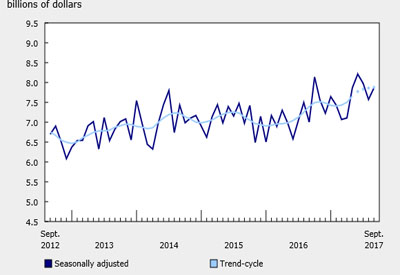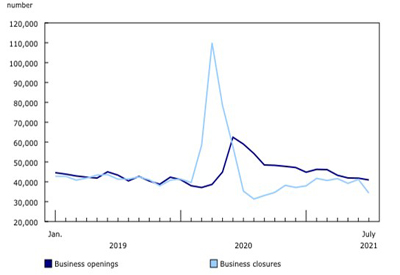Value of Building Permits Up Slightly in September

November 9, 2017
Building permits rose in September for the first time in three months, as strength in the non-residential sector outweighed some weakness in the residential sector.
Canadian municipalities issued $7.9 billion worth of building permits in September, up 3.8% from the previous month. A 1.7% decrease in the residential sector was more than offset by a 13.9% increase in the non-residential sector. A high-value institutional building permit issued in Alberta was behind much of the increase.
The institutional component refers to buildings used to house public and semi-public services such as those related to health and welfare, education, or public administration, as well as buildings used for religious services. In September, a permit for a hospital was the main contributor to the 30.0% increase in the value of institutional building permits.
The value of residential building permits edged down $82.7 million (-1.7%) to $4.8 billion in September, the third consecutive monthly decline. Ontario posted the largest decrease, mainly due to lower construction intentions for apartments.
In British Columbia, the total value of residential permits increased 15.6% to $1.0 billion, marking the third month this year that the provincial value has hit the $1.0-billion mark. Construction intentions for apartment buildings in the census metropolitan area (CMA) of Vancouver drove the increase.
Municipalities issue record level of building permits in the third quarter
Municipalities issued $23.4 billion in building permits in the third quarter, up 1.0% from the previous quarter. However, this advance was slightly below the average quarter-to-quarter growth of 1.6% since the start of 2016.
The value of institutional building permits reached $2.7 billion in the quarter, with a significant portion coming from high-value permits for hospital buildings in Alberta and Ontario.
The multi-family component totalled $7.2 billion this quarter, up 1.7% from the last quarter and the third time in four quarters that the value has exceed $7.0 billion. British Columbia, Quebec and Nova Scotia all posted record highs for the multi-family component in the quarter. At the CMA level, multi-family permits in Montreal passed the $1.0 billion-mark for the first time on record, while the CMA of Halifax accounted for over 60% of the total value of multi-family dwelling permits in the Atlantic provinces.
Nationally, the commercial component decreased 3.3% to $4.3 billion in the third quarter. However, in the province of Quebec, the value of the commercial component rose to $943.7 million, the highest value since the second quarter of 2011. This increase contributed to the province’s overall rise of 7.1%, to a record high of $4.4 billion.
For single-family dwellings, results were split between the east and west. In the third quarter of 2017, the value of single-family dwelling permits increased throughout the Atlantic provinces and Quebec. On the other hand, Ontario, the Prairie provinces and British Columbia all reported declines in the value of single-family dwellings.
Source: Statistics Canada, http://www.statcan.gc.ca/daily-quotidien/171108/dq171108a-eng.htm









